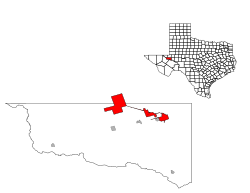Monahans, Texas
| Monahans, Texas | |
|---|---|
| City | |

Air photo of part of Monahans facing northeast in 2012
|
|
 Location of Monahans, Texas |
|
| Coordinates: 31°35′16″N 102°53′26″W / 31.58778°N 102.89056°WCoordinates: 31°35′16″N 102°53′26″W / 31.58778°N 102.89056°W | |
| Country |
|
| State |
|
| Counties | Ward, Winkler |
| Government | |
| • Mayor | David Cutbirth |
| Area | |
| • Total | 24.8 sq mi (64.3 km2) |
| • Land | 24.8 sq mi (64.3 km2) |
| • Water | 0.0 sq mi (0.0 km2) |
| Elevation | 2,621 ft (799 m) |
| Population (2010) | |
| • Total | 6,953 |
| • Density | 280/sq mi (110/km2) |
| Time zone | Central (CST) (UTC-6) |
| • Summer (DST) | CDT (UTC-5) |
| ZIP code | 79756 |
| Area code(s) | 432 |
| FIPS code | 48-48936 |
| GNIS feature ID | 1363045 |
| Website | www.cityofmonahans.org |
Monahans is a city in and the county seat of Ward County, Texas, United States. A very small portion of the city extends into Winkler County. The population was 6,953 at the 2010 census.
The Permian Basin, home to Monahans and Midland/Odessa MSA, is 250 miles (400 km) wide and 300 miles (480 km) long - Monahans is "The Center of the Permian Basin". The basin was formed during the Permian Period, the final portion of the Paleozoic Era. At the time, it was an ocean filled with abundant aquatic life.
In 1583, a Spanish explorer named Antonio de Espejo crossed this area on his way through present-day New Mexico. The Indians in the Monahans region were called "Vaqueros" by these Spanish explorers because they hunted the "hump-backed cow" or bison. Records of Spanish exploring the Los Medano (the sand dunes) outside Monahans can be traced to the early 1770s.
Located in a region where native Comanches, Mescalero, and Lipan Apache Indians once roamed, Monahans' history as a community extends back to the late 1880s with the expansion of the Texas and Pacific Railway across the south plains. For the few people living in West Texas, the building of a transcontinental railroad through the area meant the arrival of civilization. In the summer of 1881, Texas and Pacific Railroad contracted with surveyor John Thomas Monahan, who discovered that the lack of water for the laying crew and their animals would slow down construction of the rail. Monahans' digging of a water well produced an abundance of good water (250,000 US gallons (950,000 L) a day) and was instrumental in the success of the city. Prior to this solution, water had to be hauled from the area of Big Spring, Texas.
The availability of cheap land encouraged settlers to form a small community on the track known as Monahans Well. However, when oil was discovered in the area in 1926, the destiny of the community changed directions. Oil discovery brought people of many occupations and of varied interests to Monahans. The local economy began to change from an agricultural to an industrial economy,
...
Wikipedia
